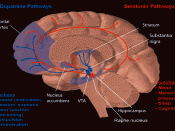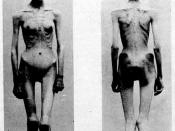"Eating disorder" has become a well known word within society today and is discussed frequently in the media. In many circles, it is "normal" for women to talk about their eating disorder and desire to stay thin. There are many disorders and conditions involving food and weight but anorexia nervosa and bulimia nervosa are the two that have gained the most attention and have become the definition of eating disorder today. Ninety to ninety five percent of people suffering from an eating disorder are women (Carson,2002) as these disorders are extremely rare in men. Eating disorders begin with a preoccupation about food and weight, but they most often end up being more about food.
Self-starvation and excessive weight loss are the main characteristics of anorexia nervosa. This eating disorder is potentially life threatening and has mortality rate of 20% over time (Carson,2002). A person suffering from this disorder is terrified of becoming fat or gaining weight and sees themselves as fat when others notice a dramatic weight loss.
This person denies the dangers of low weight and refuses to maintain a normal body weight for their height and age. The eating habits of a person suffering from anorexia are extremely restricted and many times participate in binge-eating/purging. A woman 's menstrual periods cease and a man's sex hormones may fall when suffering from anorexia. Those that develop this eating disorder tend to have many similar characteristics including irritability, depression, poor adaption to change, perfectionism, and have a fear of growing up.
A person suffering from bulimia nervosa has normal and regular binge-eating episodes and tend to feel out of control while eating. The use of vomiting, excessive exercise, fasting, laxatives, or suppositories tend to be regular patterns for a person with this disorder although there are cases...


